Analyzing Business Law: Partnership, Contracts, and Consumer Rights
VerifiedAdded on 2023/06/10
|9
|1814
|281
Case Study
AI Summary
This case study delves into various aspects of business and corporation law, analyzing scenarios related to partnership agreements, contractual obligations, and consumer rights. The first case examines the validity of a partnership contract between Lance and Lynton, focusing on the disclosure of purchasing limits and potential liabilities. The second case addresses whether Saqlaim is bound by a contract and explores consumer remedies related to misleading advertising claims about a moisturizer. The analysis references relevant legal principles and case laws, such as Cox v. Hickman and Director of Consumer Affairs Victoria v Gibson, to evaluate the legal implications. The final case discusses whether Felix can sue Xiaozing for a promised amount, applying the rule of consideration and referencing cases like Stilk v Myrrick and Williams v Roffey Bros to determine the validity of the promise. This document is available on Desklib, where students can find a wealth of resources, including past papers and solved assignments.
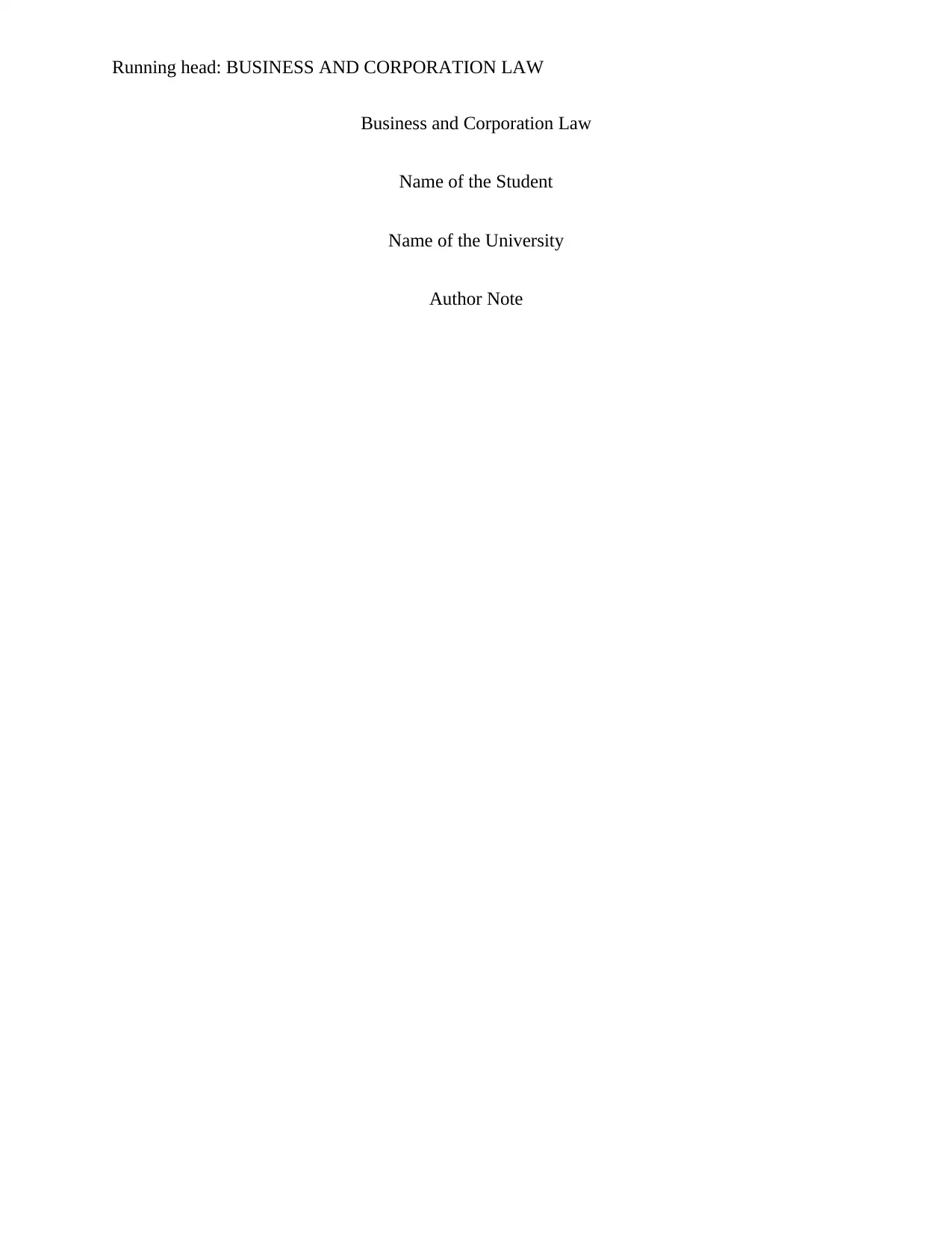
Running head: BUSINESS AND CORPORATION LAW
Business and Corporation Law
Name of the Student
Name of the University
Author Note
Business and Corporation Law
Name of the Student
Name of the University
Author Note
Paraphrase This Document
Need a fresh take? Get an instant paraphrase of this document with our AI Paraphraser
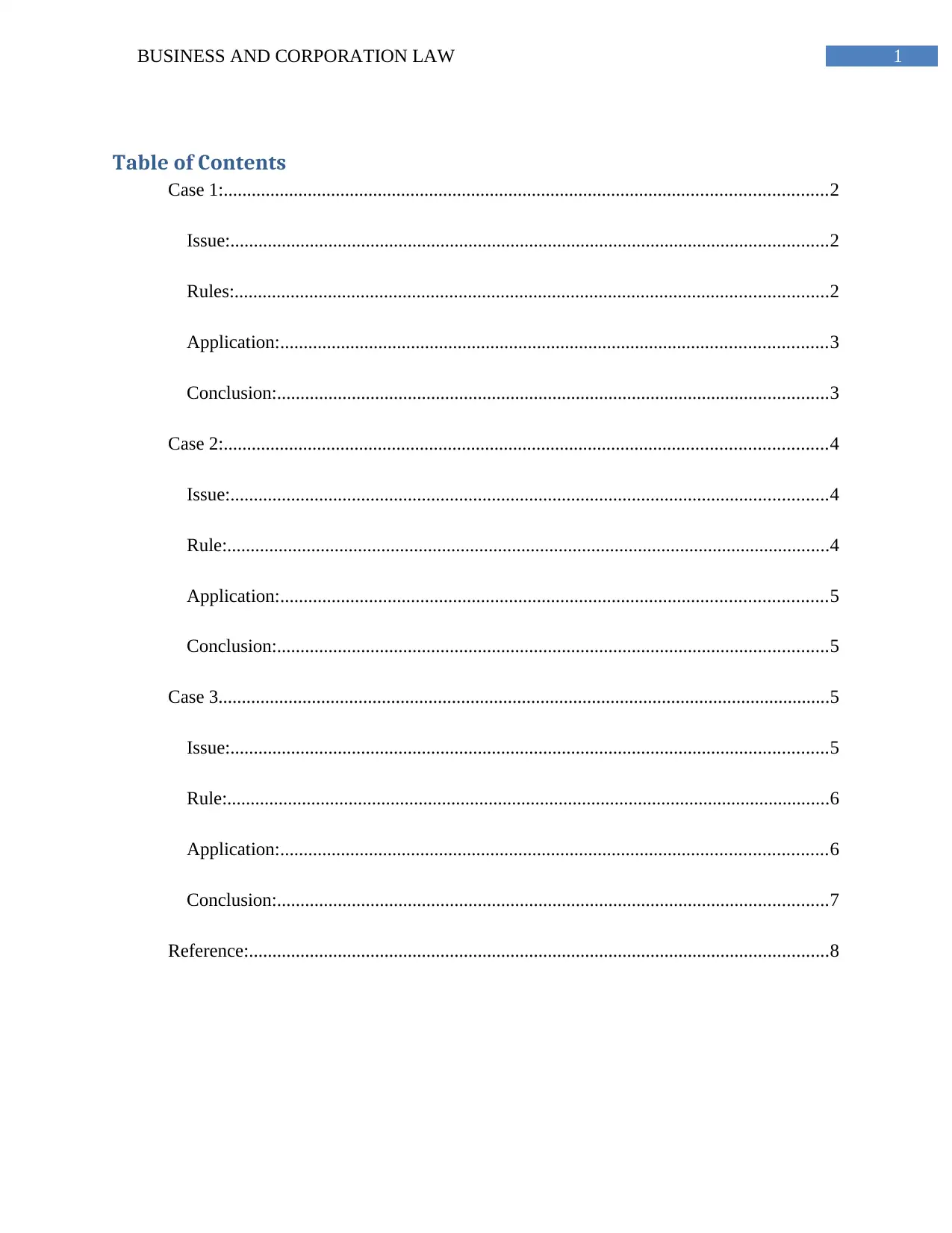
1BUSINESS AND CORPORATION LAW
Table of Contents
Case 1:.................................................................................................................................2
Issue:................................................................................................................................2
Rules:...............................................................................................................................2
Application:.....................................................................................................................3
Conclusion:......................................................................................................................3
Case 2:.................................................................................................................................4
Issue:................................................................................................................................4
Rule:.................................................................................................................................4
Application:.....................................................................................................................5
Conclusion:......................................................................................................................5
Case 3...................................................................................................................................5
Issue:................................................................................................................................5
Rule:.................................................................................................................................6
Application:.....................................................................................................................6
Conclusion:......................................................................................................................7
Reference:............................................................................................................................8
Table of Contents
Case 1:.................................................................................................................................2
Issue:................................................................................................................................2
Rules:...............................................................................................................................2
Application:.....................................................................................................................3
Conclusion:......................................................................................................................3
Case 2:.................................................................................................................................4
Issue:................................................................................................................................4
Rule:.................................................................................................................................4
Application:.....................................................................................................................5
Conclusion:......................................................................................................................5
Case 3...................................................................................................................................5
Issue:................................................................................................................................5
Rule:.................................................................................................................................6
Application:.....................................................................................................................6
Conclusion:......................................................................................................................7
Reference:............................................................................................................................8
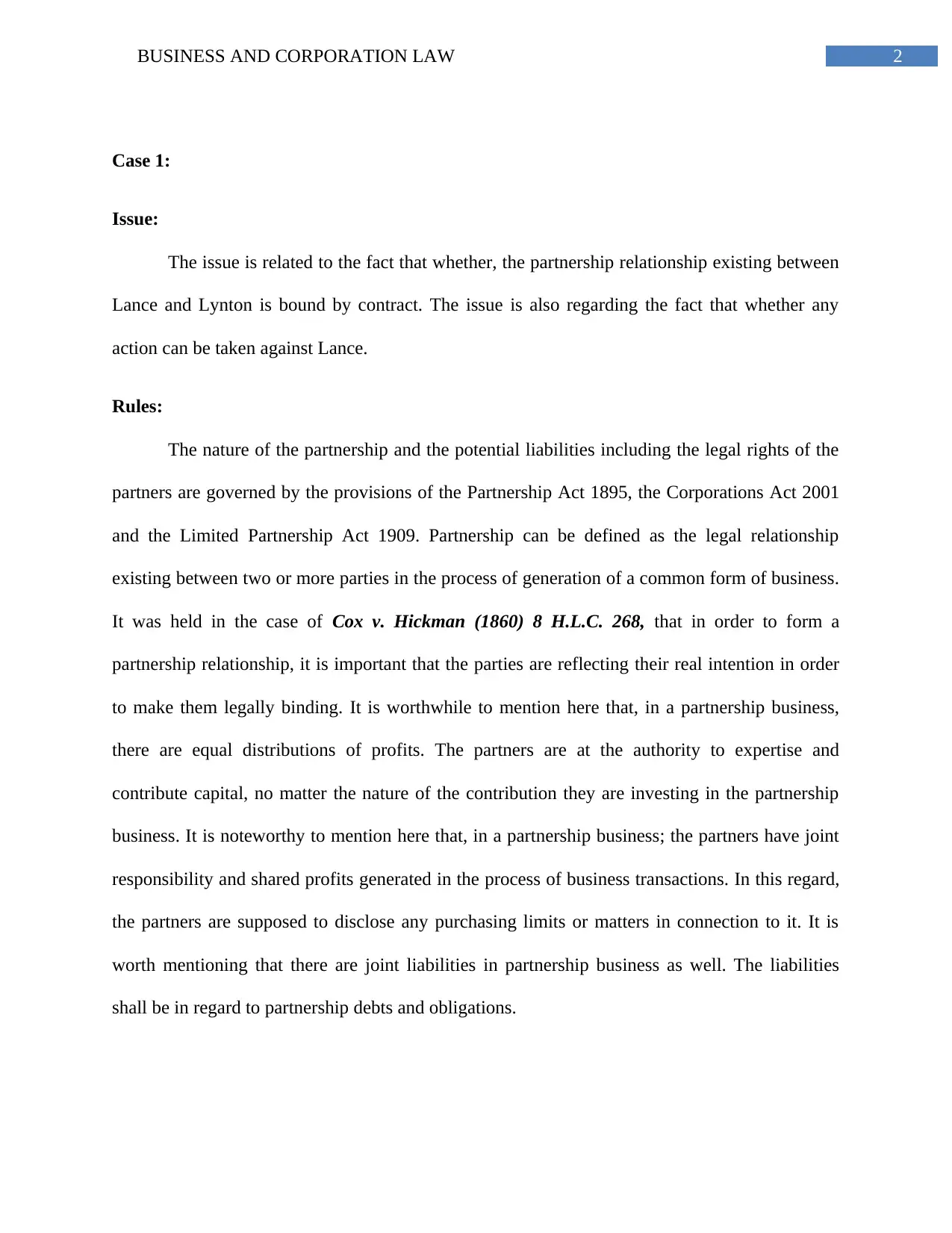
2BUSINESS AND CORPORATION LAW
Case 1:
Issue:
The issue is related to the fact that whether, the partnership relationship existing between
Lance and Lynton is bound by contract. The issue is also regarding the fact that whether any
action can be taken against Lance.
Rules:
The nature of the partnership and the potential liabilities including the legal rights of the
partners are governed by the provisions of the Partnership Act 1895, the Corporations Act 2001
and the Limited Partnership Act 1909. Partnership can be defined as the legal relationship
existing between two or more parties in the process of generation of a common form of business.
It was held in the case of Cox v. Hickman (1860) 8 H.L.C. 268, that in order to form a
partnership relationship, it is important that the parties are reflecting their real intention in order
to make them legally binding. It is worthwhile to mention here that, in a partnership business,
there are equal distributions of profits. The partners are at the authority to expertise and
contribute capital, no matter the nature of the contribution they are investing in the partnership
business. It is noteworthy to mention here that, in a partnership business; the partners have joint
responsibility and shared profits generated in the process of business transactions. In this regard,
the partners are supposed to disclose any purchasing limits or matters in connection to it. It is
worth mentioning that there are joint liabilities in partnership business as well. The liabilities
shall be in regard to partnership debts and obligations.
Case 1:
Issue:
The issue is related to the fact that whether, the partnership relationship existing between
Lance and Lynton is bound by contract. The issue is also regarding the fact that whether any
action can be taken against Lance.
Rules:
The nature of the partnership and the potential liabilities including the legal rights of the
partners are governed by the provisions of the Partnership Act 1895, the Corporations Act 2001
and the Limited Partnership Act 1909. Partnership can be defined as the legal relationship
existing between two or more parties in the process of generation of a common form of business.
It was held in the case of Cox v. Hickman (1860) 8 H.L.C. 268, that in order to form a
partnership relationship, it is important that the parties are reflecting their real intention in order
to make them legally binding. It is worthwhile to mention here that, in a partnership business,
there are equal distributions of profits. The partners are at the authority to expertise and
contribute capital, no matter the nature of the contribution they are investing in the partnership
business. It is noteworthy to mention here that, in a partnership business; the partners have joint
responsibility and shared profits generated in the process of business transactions. In this regard,
the partners are supposed to disclose any purchasing limits or matters in connection to it. It is
worth mentioning that there are joint liabilities in partnership business as well. The liabilities
shall be in regard to partnership debts and obligations.
⊘ This is a preview!⊘
Do you want full access?
Subscribe today to unlock all pages.

Trusted by 1+ million students worldwide
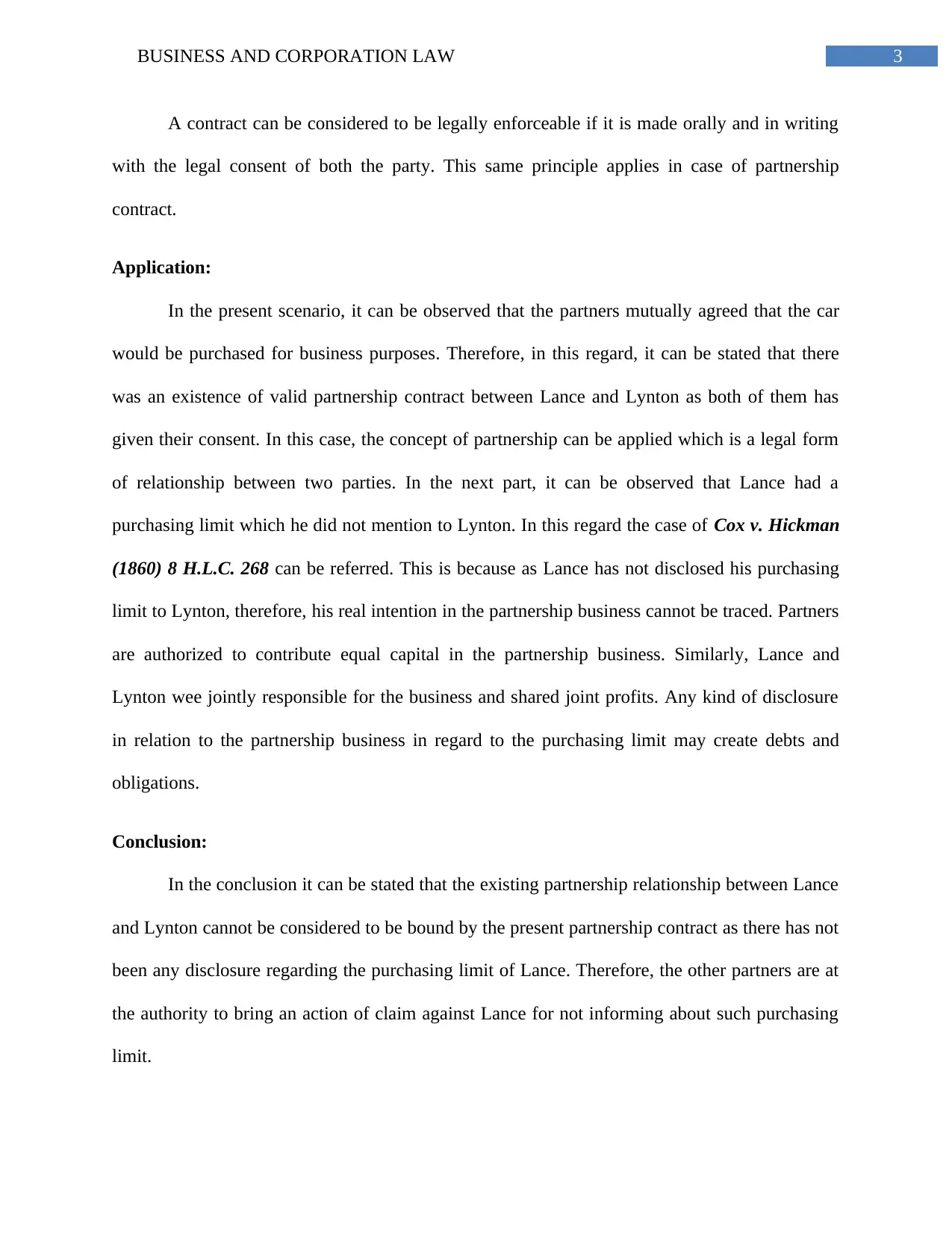
3BUSINESS AND CORPORATION LAW
A contract can be considered to be legally enforceable if it is made orally and in writing
with the legal consent of both the party. This same principle applies in case of partnership
contract.
Application:
In the present scenario, it can be observed that the partners mutually agreed that the car
would be purchased for business purposes. Therefore, in this regard, it can be stated that there
was an existence of valid partnership contract between Lance and Lynton as both of them has
given their consent. In this case, the concept of partnership can be applied which is a legal form
of relationship between two parties. In the next part, it can be observed that Lance had a
purchasing limit which he did not mention to Lynton. In this regard the case of Cox v. Hickman
(1860) 8 H.L.C. 268 can be referred. This is because as Lance has not disclosed his purchasing
limit to Lynton, therefore, his real intention in the partnership business cannot be traced. Partners
are authorized to contribute equal capital in the partnership business. Similarly, Lance and
Lynton wee jointly responsible for the business and shared joint profits. Any kind of disclosure
in relation to the partnership business in regard to the purchasing limit may create debts and
obligations.
Conclusion:
In the conclusion it can be stated that the existing partnership relationship between Lance
and Lynton cannot be considered to be bound by the present partnership contract as there has not
been any disclosure regarding the purchasing limit of Lance. Therefore, the other partners are at
the authority to bring an action of claim against Lance for not informing about such purchasing
limit.
A contract can be considered to be legally enforceable if it is made orally and in writing
with the legal consent of both the party. This same principle applies in case of partnership
contract.
Application:
In the present scenario, it can be observed that the partners mutually agreed that the car
would be purchased for business purposes. Therefore, in this regard, it can be stated that there
was an existence of valid partnership contract between Lance and Lynton as both of them has
given their consent. In this case, the concept of partnership can be applied which is a legal form
of relationship between two parties. In the next part, it can be observed that Lance had a
purchasing limit which he did not mention to Lynton. In this regard the case of Cox v. Hickman
(1860) 8 H.L.C. 268 can be referred. This is because as Lance has not disclosed his purchasing
limit to Lynton, therefore, his real intention in the partnership business cannot be traced. Partners
are authorized to contribute equal capital in the partnership business. Similarly, Lance and
Lynton wee jointly responsible for the business and shared joint profits. Any kind of disclosure
in relation to the partnership business in regard to the purchasing limit may create debts and
obligations.
Conclusion:
In the conclusion it can be stated that the existing partnership relationship between Lance
and Lynton cannot be considered to be bound by the present partnership contract as there has not
been any disclosure regarding the purchasing limit of Lance. Therefore, the other partners are at
the authority to bring an action of claim against Lance for not informing about such purchasing
limit.
Paraphrase This Document
Need a fresh take? Get an instant paraphrase of this document with our AI Paraphraser
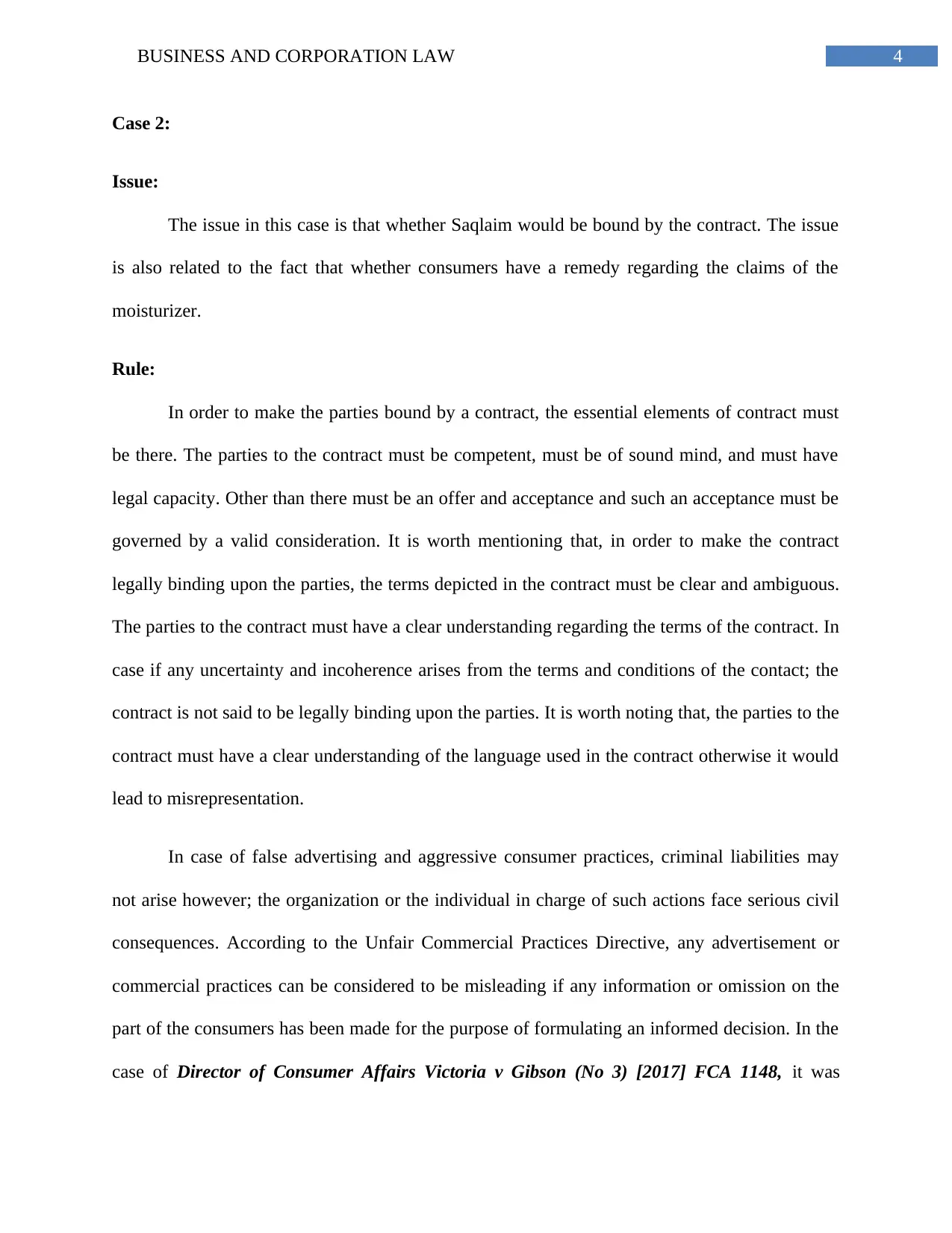
4BUSINESS AND CORPORATION LAW
Case 2:
Issue:
The issue in this case is that whether Saqlaim would be bound by the contract. The issue
is also related to the fact that whether consumers have a remedy regarding the claims of the
moisturizer.
Rule:
In order to make the parties bound by a contract, the essential elements of contract must
be there. The parties to the contract must be competent, must be of sound mind, and must have
legal capacity. Other than there must be an offer and acceptance and such an acceptance must be
governed by a valid consideration. It is worth mentioning that, in order to make the contract
legally binding upon the parties, the terms depicted in the contract must be clear and ambiguous.
The parties to the contract must have a clear understanding regarding the terms of the contract. In
case if any uncertainty and incoherence arises from the terms and conditions of the contact; the
contract is not said to be legally binding upon the parties. It is worth noting that, the parties to the
contract must have a clear understanding of the language used in the contract otherwise it would
lead to misrepresentation.
In case of false advertising and aggressive consumer practices, criminal liabilities may
not arise however; the organization or the individual in charge of such actions face serious civil
consequences. According to the Unfair Commercial Practices Directive, any advertisement or
commercial practices can be considered to be misleading if any information or omission on the
part of the consumers has been made for the purpose of formulating an informed decision. In the
case of Director of Consumer Affairs Victoria v Gibson (No 3) [2017] FCA 1148, it was
Case 2:
Issue:
The issue in this case is that whether Saqlaim would be bound by the contract. The issue
is also related to the fact that whether consumers have a remedy regarding the claims of the
moisturizer.
Rule:
In order to make the parties bound by a contract, the essential elements of contract must
be there. The parties to the contract must be competent, must be of sound mind, and must have
legal capacity. Other than there must be an offer and acceptance and such an acceptance must be
governed by a valid consideration. It is worth mentioning that, in order to make the contract
legally binding upon the parties, the terms depicted in the contract must be clear and ambiguous.
The parties to the contract must have a clear understanding regarding the terms of the contract. In
case if any uncertainty and incoherence arises from the terms and conditions of the contact; the
contract is not said to be legally binding upon the parties. It is worth noting that, the parties to the
contract must have a clear understanding of the language used in the contract otherwise it would
lead to misrepresentation.
In case of false advertising and aggressive consumer practices, criminal liabilities may
not arise however; the organization or the individual in charge of such actions face serious civil
consequences. According to the Unfair Commercial Practices Directive, any advertisement or
commercial practices can be considered to be misleading if any information or omission on the
part of the consumers has been made for the purpose of formulating an informed decision. In the
case of Director of Consumer Affairs Victoria v Gibson (No 3) [2017] FCA 1148, it was
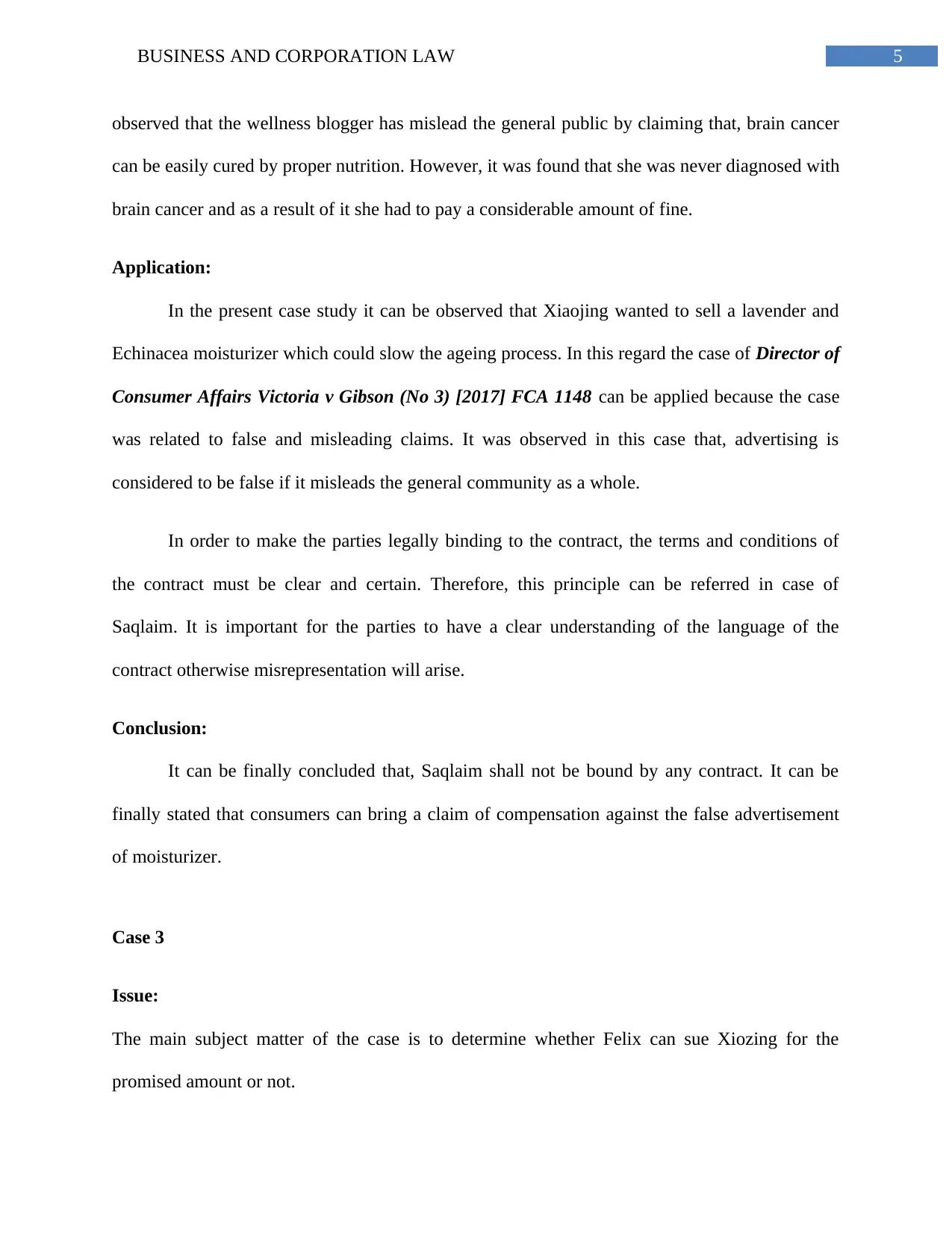
5BUSINESS AND CORPORATION LAW
observed that the wellness blogger has mislead the general public by claiming that, brain cancer
can be easily cured by proper nutrition. However, it was found that she was never diagnosed with
brain cancer and as a result of it she had to pay a considerable amount of fine.
Application:
In the present case study it can be observed that Xiaojing wanted to sell a lavender and
Echinacea moisturizer which could slow the ageing process. In this regard the case of Director of
Consumer Affairs Victoria v Gibson (No 3) [2017] FCA 1148 can be applied because the case
was related to false and misleading claims. It was observed in this case that, advertising is
considered to be false if it misleads the general community as a whole.
In order to make the parties legally binding to the contract, the terms and conditions of
the contract must be clear and certain. Therefore, this principle can be referred in case of
Saqlaim. It is important for the parties to have a clear understanding of the language of the
contract otherwise misrepresentation will arise.
Conclusion:
It can be finally concluded that, Saqlaim shall not be bound by any contract. It can be
finally stated that consumers can bring a claim of compensation against the false advertisement
of moisturizer.
Case 3
Issue:
The main subject matter of the case is to determine whether Felix can sue Xiozing for the
promised amount or not.
observed that the wellness blogger has mislead the general public by claiming that, brain cancer
can be easily cured by proper nutrition. However, it was found that she was never diagnosed with
brain cancer and as a result of it she had to pay a considerable amount of fine.
Application:
In the present case study it can be observed that Xiaojing wanted to sell a lavender and
Echinacea moisturizer which could slow the ageing process. In this regard the case of Director of
Consumer Affairs Victoria v Gibson (No 3) [2017] FCA 1148 can be applied because the case
was related to false and misleading claims. It was observed in this case that, advertising is
considered to be false if it misleads the general community as a whole.
In order to make the parties legally binding to the contract, the terms and conditions of
the contract must be clear and certain. Therefore, this principle can be referred in case of
Saqlaim. It is important for the parties to have a clear understanding of the language of the
contract otherwise misrepresentation will arise.
Conclusion:
It can be finally concluded that, Saqlaim shall not be bound by any contract. It can be
finally stated that consumers can bring a claim of compensation against the false advertisement
of moisturizer.
Case 3
Issue:
The main subject matter of the case is to determine whether Felix can sue Xiozing for the
promised amount or not.
⊘ This is a preview!⊘
Do you want full access?
Subscribe today to unlock all pages.

Trusted by 1+ million students worldwide
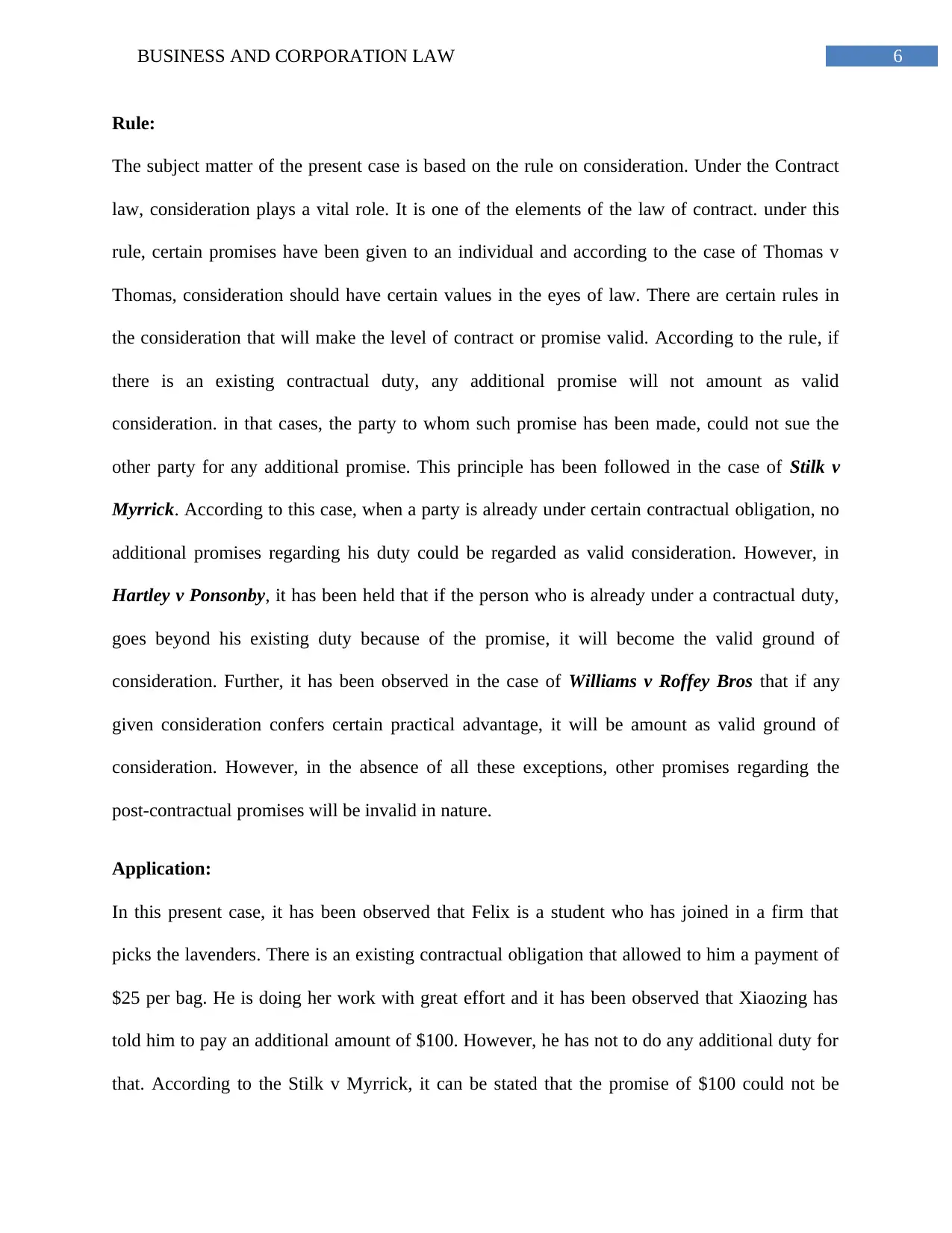
6BUSINESS AND CORPORATION LAW
Rule:
The subject matter of the present case is based on the rule on consideration. Under the Contract
law, consideration plays a vital role. It is one of the elements of the law of contract. under this
rule, certain promises have been given to an individual and according to the case of Thomas v
Thomas, consideration should have certain values in the eyes of law. There are certain rules in
the consideration that will make the level of contract or promise valid. According to the rule, if
there is an existing contractual duty, any additional promise will not amount as valid
consideration. in that cases, the party to whom such promise has been made, could not sue the
other party for any additional promise. This principle has been followed in the case of Stilk v
Myrrick. According to this case, when a party is already under certain contractual obligation, no
additional promises regarding his duty could be regarded as valid consideration. However, in
Hartley v Ponsonby, it has been held that if the person who is already under a contractual duty,
goes beyond his existing duty because of the promise, it will become the valid ground of
consideration. Further, it has been observed in the case of Williams v Roffey Bros that if any
given consideration confers certain practical advantage, it will be amount as valid ground of
consideration. However, in the absence of all these exceptions, other promises regarding the
post-contractual promises will be invalid in nature.
Application:
In this present case, it has been observed that Felix is a student who has joined in a firm that
picks the lavenders. There is an existing contractual obligation that allowed to him a payment of
$25 per bag. He is doing her work with great effort and it has been observed that Xiaozing has
told him to pay an additional amount of $100. However, he has not to do any additional duty for
that. According to the Stilk v Myrrick, it can be stated that the promise of $100 could not be
Rule:
The subject matter of the present case is based on the rule on consideration. Under the Contract
law, consideration plays a vital role. It is one of the elements of the law of contract. under this
rule, certain promises have been given to an individual and according to the case of Thomas v
Thomas, consideration should have certain values in the eyes of law. There are certain rules in
the consideration that will make the level of contract or promise valid. According to the rule, if
there is an existing contractual duty, any additional promise will not amount as valid
consideration. in that cases, the party to whom such promise has been made, could not sue the
other party for any additional promise. This principle has been followed in the case of Stilk v
Myrrick. According to this case, when a party is already under certain contractual obligation, no
additional promises regarding his duty could be regarded as valid consideration. However, in
Hartley v Ponsonby, it has been held that if the person who is already under a contractual duty,
goes beyond his existing duty because of the promise, it will become the valid ground of
consideration. Further, it has been observed in the case of Williams v Roffey Bros that if any
given consideration confers certain practical advantage, it will be amount as valid ground of
consideration. However, in the absence of all these exceptions, other promises regarding the
post-contractual promises will be invalid in nature.
Application:
In this present case, it has been observed that Felix is a student who has joined in a firm that
picks the lavenders. There is an existing contractual obligation that allowed to him a payment of
$25 per bag. He is doing her work with great effort and it has been observed that Xiaozing has
told him to pay an additional amount of $100. However, he has not to do any additional duty for
that. According to the Stilk v Myrrick, it can be stated that the promise of $100 could not be
Paraphrase This Document
Need a fresh take? Get an instant paraphrase of this document with our AI Paraphraser
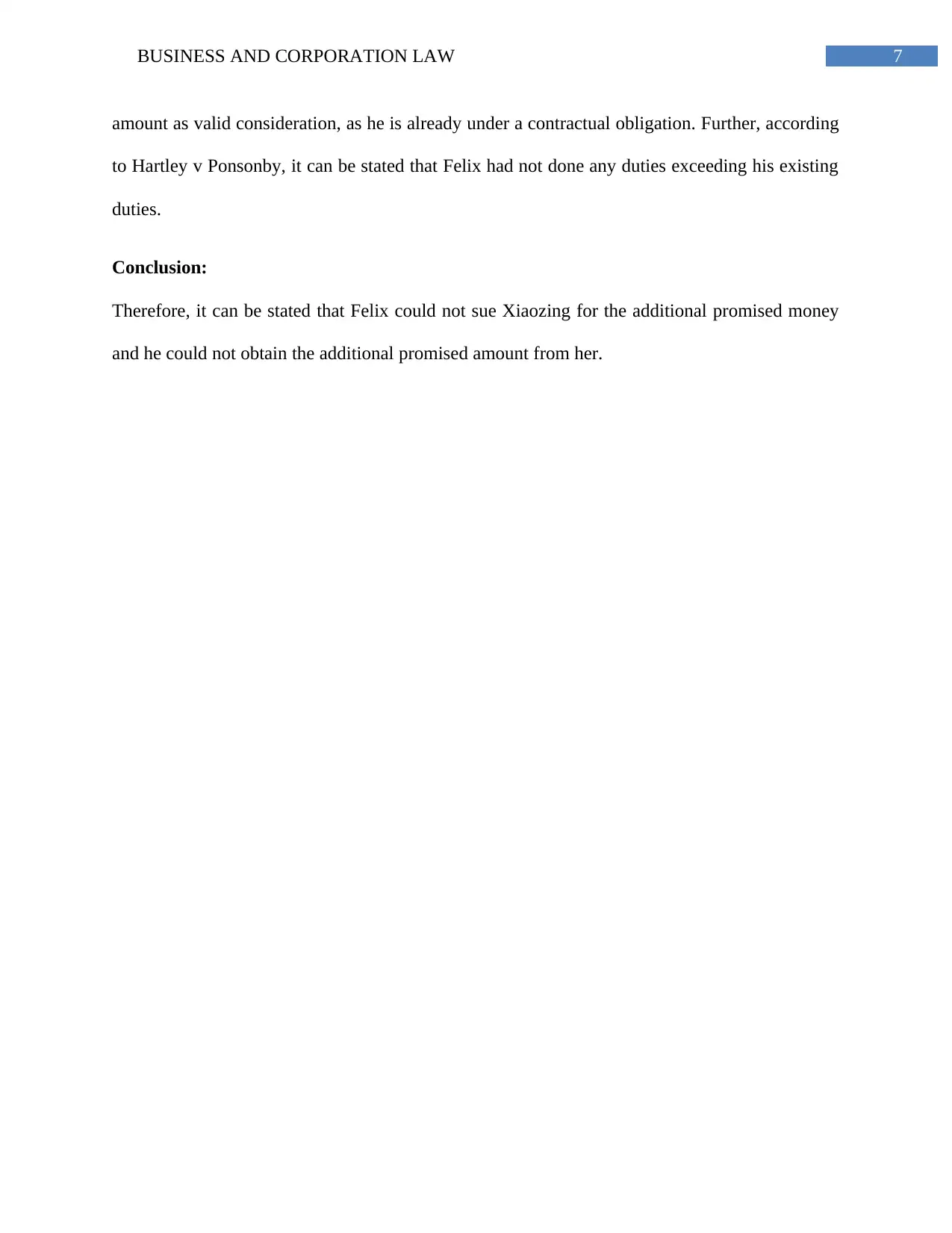
7BUSINESS AND CORPORATION LAW
amount as valid consideration, as he is already under a contractual obligation. Further, according
to Hartley v Ponsonby, it can be stated that Felix had not done any duties exceeding his existing
duties.
Conclusion:
Therefore, it can be stated that Felix could not sue Xiaozing for the additional promised money
and he could not obtain the additional promised amount from her.
amount as valid consideration, as he is already under a contractual obligation. Further, according
to Hartley v Ponsonby, it can be stated that Felix had not done any duties exceeding his existing
duties.
Conclusion:
Therefore, it can be stated that Felix could not sue Xiaozing for the additional promised money
and he could not obtain the additional promised amount from her.
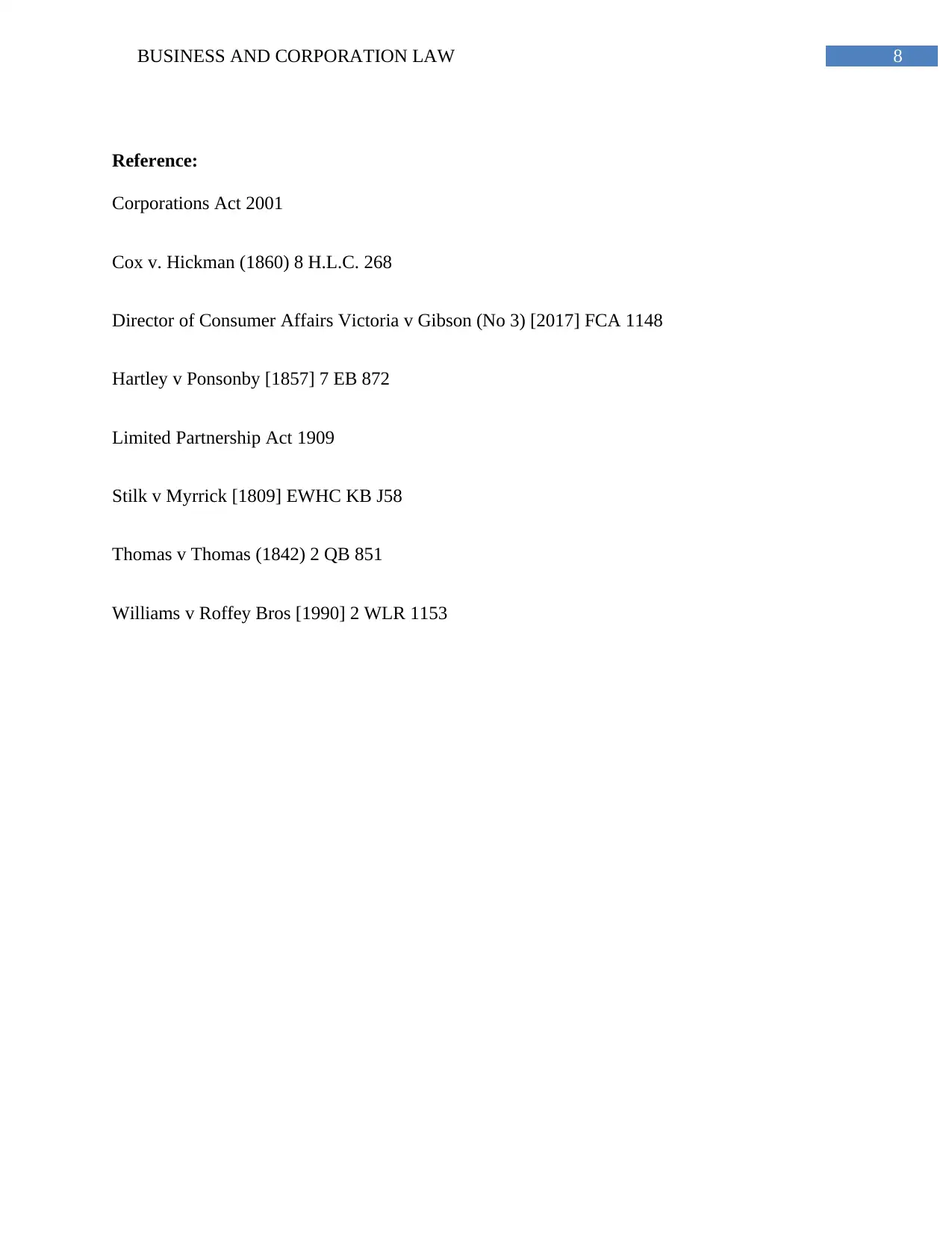
8BUSINESS AND CORPORATION LAW
Reference:
Corporations Act 2001
Cox v. Hickman (1860) 8 H.L.C. 268
Director of Consumer Affairs Victoria v Gibson (No 3) [2017] FCA 1148
Hartley v Ponsonby [1857] 7 EB 872
Limited Partnership Act 1909
Stilk v Myrrick [1809] EWHC KB J58
Thomas v Thomas (1842) 2 QB 851
Williams v Roffey Bros [1990] 2 WLR 1153
Reference:
Corporations Act 2001
Cox v. Hickman (1860) 8 H.L.C. 268
Director of Consumer Affairs Victoria v Gibson (No 3) [2017] FCA 1148
Hartley v Ponsonby [1857] 7 EB 872
Limited Partnership Act 1909
Stilk v Myrrick [1809] EWHC KB J58
Thomas v Thomas (1842) 2 QB 851
Williams v Roffey Bros [1990] 2 WLR 1153
⊘ This is a preview!⊘
Do you want full access?
Subscribe today to unlock all pages.

Trusted by 1+ million students worldwide
1 out of 9
Related Documents
Your All-in-One AI-Powered Toolkit for Academic Success.
+13062052269
info@desklib.com
Available 24*7 on WhatsApp / Email
![[object Object]](/_next/static/media/star-bottom.7253800d.svg)
Unlock your academic potential
Copyright © 2020–2025 A2Z Services. All Rights Reserved. Developed and managed by ZUCOL.




